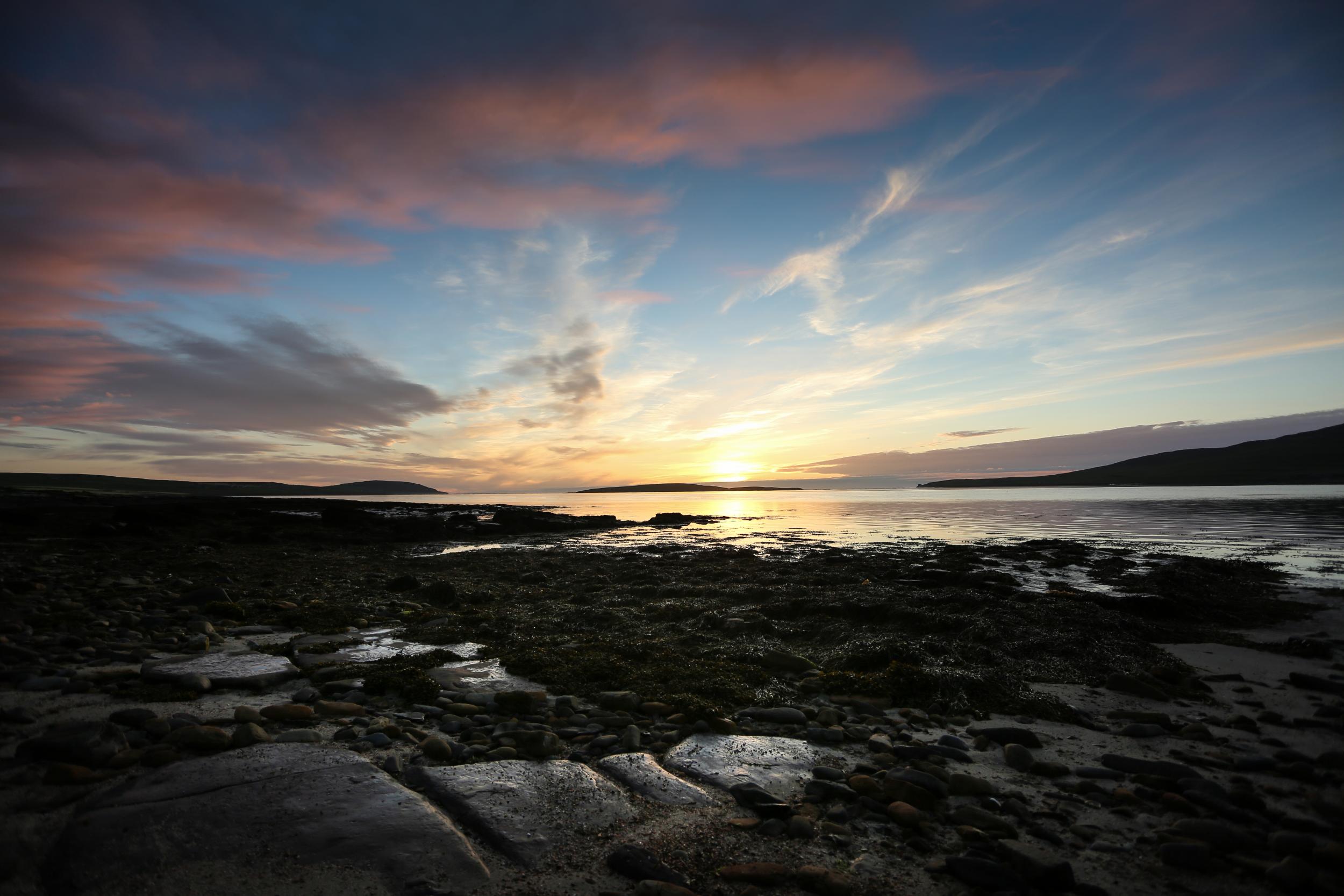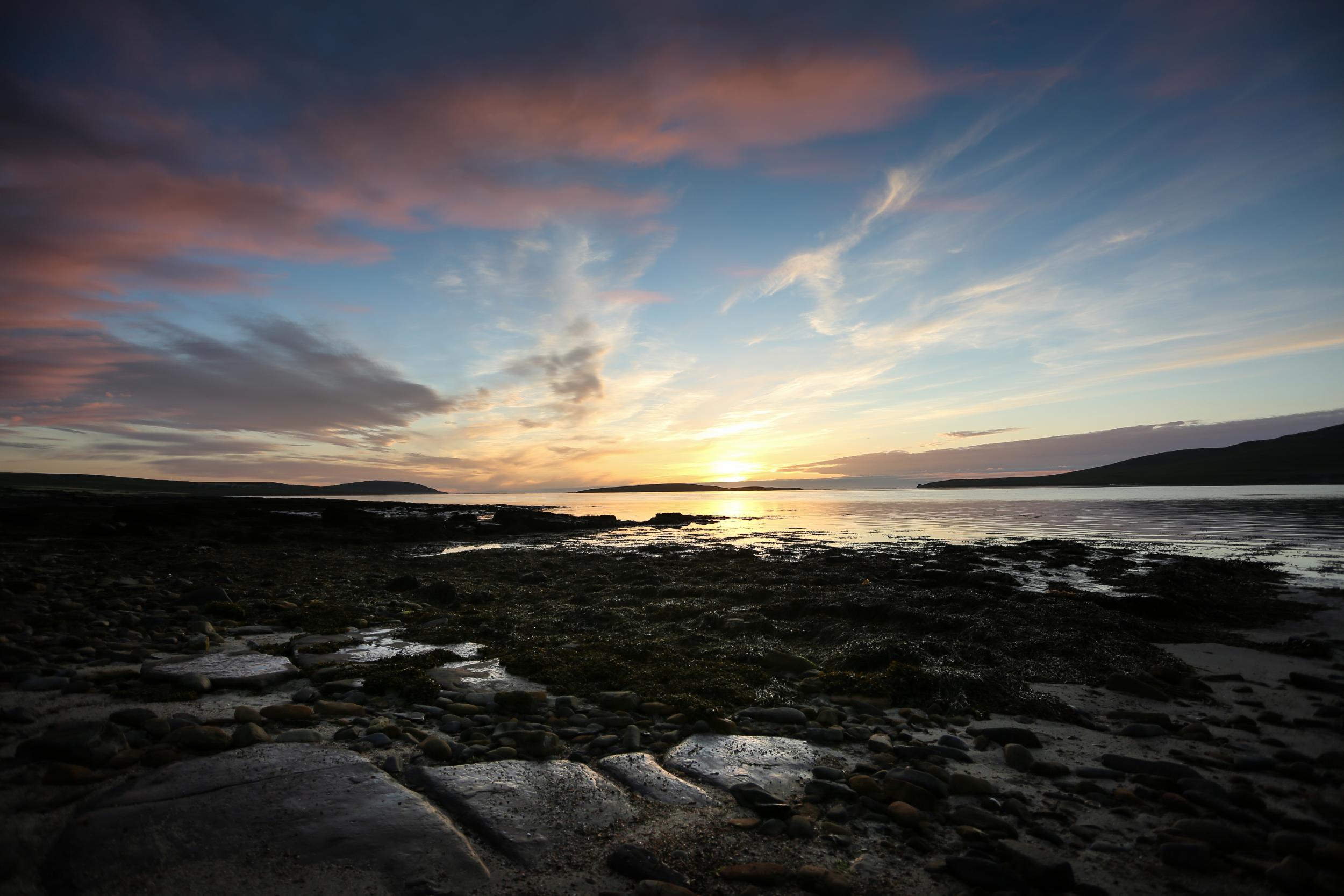
The Independent’s hotel recommendations are unbiased, independent advice you can trust. On some occasions, we earn revenue if you click the links and book, but we never allow this to affect our coverage.
Down to my right, the waters of Loch Swannay shine in the sunlight. All is calm there. It’s a different story down to my left in Eynhallow Sound, where the Atlantic meets the North Sea. They pile into each other with furious eruptions of foam and spray, while further out to sea, heavy waves smash into the cliffs at Rousay Island. Curtains of sea mist rise and fall over each scene before me. I have grandstand views of them all from my perch between loch and sea in a clump of purple heather high on Costa Hill.
I’m walking the St Magnus Way in Orkney, one of Britain’s newest hiking trails. It was officially inaugurated in 2017, but has since been developed and extended. St Magnus is Orkney’s patron saint, martyred around 1117AD and buried on the small island of Egilsay. Later on, his remains were returned to mainland Orkney – the St Magnus Way follows the 55-mile route through which they are believed to have travelled. If that sounds a little morbid, don’t be deterred: the trail takes in some of the best scenery in the British Isles. This is a pilgrimage route but – like the Camino de Santiago in Spain – it’s open to everyone. You can walk as little or as much of it as you want, guided by the St Magnus Way smartphone app (downloadable from stmagnusway.com). As well as ensuring you won’t get lost, the app offers commentaries en route via bluetooth beacons.
1/8
Iain Sarjeant/VisitScotland
2/8
3/8
Getty
4/8
5/8
6/8
7/8
Iain Sarjeant / VisitScotland
8/8
Paul Tomkins/VisitScotland
1/8
Iain Sarjeant/VisitScotland
2/8
3/8
Getty
4/8
5/8
6/8
7/8
Iain Sarjeant / VisitScotland
8/8
Paul Tomkins/VisitScotland
This trail is saturated in history. A notable landmark is the Round Kirk at Ophir, built in penitence by Haakon, St Magnus’s killer. This is one of Scotland’s oldest round churches, with ruins resembling a broken tea pot. It overlooks Scapa Flow, a vast plain of water that ranks among the northern hemisphere’s greatest natural harbours and was a stronghold for the Royal Navy during both World Wars.
Next door are the remains of a Viking drinking hall, Earl’s Bu. You had to watch yourself on a night out with the Vikings: their drinking sessions were strenuous and imbibing less than your companions could be dangerous. A dispute in Earl’s Bu over who was downing what ended in two axe slayings, recorded in the Orkneyinga Saga. The small exhibition centre nearby has all the satisfyingly gory details.
Some of St Magnus Way can be hard going – before ascending Costa Hill I had to scramble over boulders on the beach at Eynhallow Sound, shadowed offshore all the while by a posse of inquisitive seals. Yet one of the easiest sections, the route’s latest addition on Egilsay, is among the finest.
The ferry out to the island takes me past its sister isles of Rousay and Wyre, smooth green mounds rising from the sea. They are small, but remain inhabited; Egilsay itself has a population of just 18 residents. Its skyline is dominated by the ruins of St Magnus Church, built in the 12th century near the site of his death. As I wander the church’s ruins, swifts and skylarks dart around an adjacent barley field. On the island’s far side I swim from Magnus beach, where yellow flowers of sow thistle border the modest crescent of pale sand. There’s nobody about, save six Shetland Heifers, who observe me with intense curiosity as I disrobe to brave turquoise waters as clean as they are clear.
Hiking requires food and drink in generous quantities: I dine in two outstanding Orkney restaurants, the Foveran in Kirkwall and the Hamnavoe in Stromness. Each prides itself on the freshness of its fish – I choose megrim in the former and plaice in the latter, both landed on the island of Westray. Sandwiched in between these excellent meals, I take a tour of the Orkney brewery, housed in a former Victorian school with its own restaurant and bar. My favourite brew is its award-winning Dark Island, a porter with flavours of fruit, nuts and – most notably – chocolate. For something stronger, I swing by the Highland Park distillery. It owns some of the land along the St Magnus Way and digs peat from it to accent a small range of wonderfully smoky malts.
St Magnus’s bones were finally laid to rest in Kirkwall Cathedral, built by his nephew Rognvald, who was a poet and a warrior. Rognvald travelled to Palestine on his own pilgrimage, a voyage full of feasting and fighting which ended back in Kirkwall, where he hung up the sails from his ship to dry in the cathedral. I opt for a tour of the upper levels and take in one final view, this time over the town’s small island of sandstone buildings, resplendent amid a sea of surrounding countryside. My own pilgrimage may not have been quite as adventurous as Rognvald’s, but I’d wager it’s been just as beautiful.
Travel essentials
Getting there
Loganair flies direct to Kirkwall from Aberdeen, Inverness, Edinburgh and Glasgow. Northlink runs a ferry service from Aberdeen to Kirkwall.
Staying there
The Storehouse in Kirkwall has doubles from £160, B&B.
